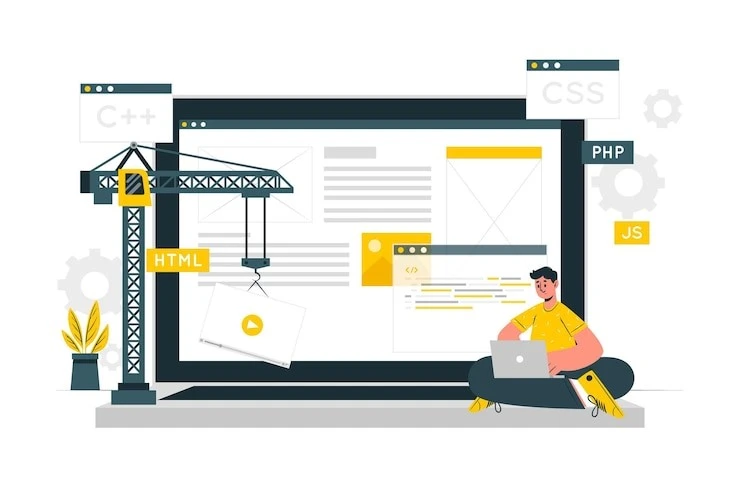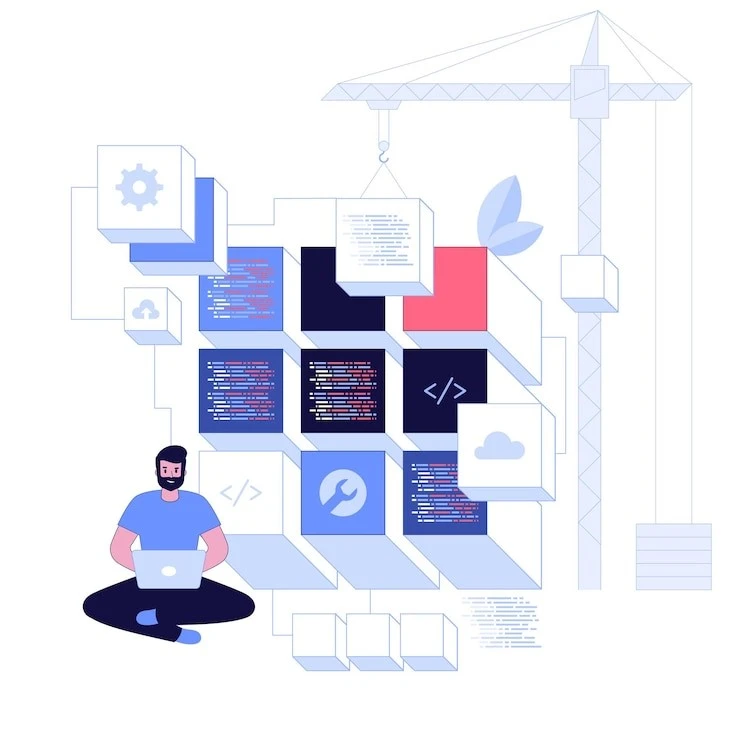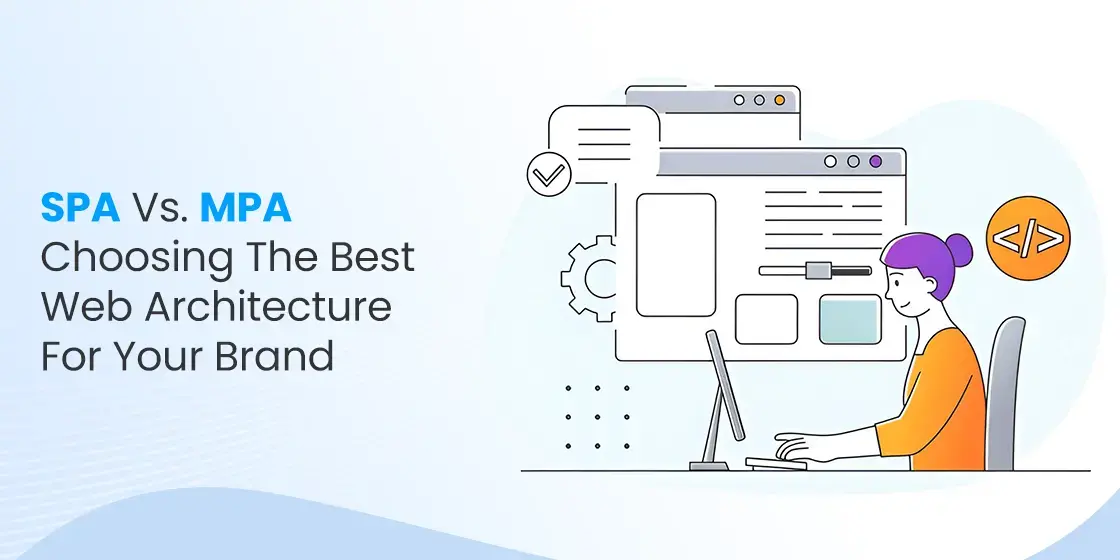Table of Content
Discover Which Web Architecture Among SPA vs MPA is Better for Your Site
In web development, the architecture on which a website or web application is built plays a crucial role in shaping its performance, user experience, and overall scalability. Two prominent architectural patterns that developers often consider are Single-Page Applications (SPAs) and Multi-Page Applications (MPAs).
Both SPA vs MPA offer distinct advantages and cons, making the choice between them a significant decision that can impact a brand’s online presence and ability to engage with its audience significantly. Understanding the core principles, benefits, and trade-offs of SPAs and MPAs is essential for businesses to make informed decisions about which architecture best aligns with their specific needs, goals, and the nature of their online offerings.
In this article, we will dive into the details of both SPA and MPA, and explore their defining characteristics, benefits, and real-world examples from the top web development services. Moreover, we will explore how and when to choose one architecture over the other, empowering you to make informed decisions that optimize their web presence and user engagement.
What is Single-Page Architecture (SPA)?

Single-Page Architecture (SPA) is a modern web development approach where a single HTML page is loaded initially, and subsequent interactions with the application dynamically update the content within that page without requiring full page reloads from the server.
This is achieved through the use of JavaScript frameworks and libraries like React, Angular, and Vue.js, which handle the rendering and manipulation of the Document Object Model (DOM) in the user’s browser. When a user navigates within an SPA, the browser communicates with the server primarily to fetch data (often in JSON or XML format) and then JavaScript on the client-side updates the relevant sections of the page, creating a seamless and responsive user experience.
The core principle behind SPA is to minimize the amount of data transferred between the client and the server after the initial page load. Instead of requesting and rendering entire new HTML pages for each interaction, only the necessary data is exchanged, leading to faster perceived performance and a more fluid user experience that mimics the responsiveness of a desktop application.
This approach relies heavily on client-side rendering, where the browser handles the rendering of the user interface based on the data received from the server. SPAs are particularly well-suited for complex, interactive web app development that require rich user interfaces and frequent data updates, such as social media platforms, email clients, and collaborative tools.
Elevate your online presence with websites that blend visual appeal with advanced functionalities. Explore our tailored web development solutions today.
Discover Web SolutionsBenefits of SPA
Single-Page Architectures offer several compelling benefits that make them a popular choice for modern web applications:
- Enhanced user experience (UX): By eliminating full page reloads, navigation within the application feels significantly faster and more fluid. The dynamic nature of SPAs allows for richer and more interactive user interfaces, contributing to a more compelling and user-friendly experience.
- Improved performance after the initial load: Once the application shell is loaded, subsequent data requests are small and efficient, as only necessary data is transferred between the client and the server. The ability to cache static assets on the client-side leads to faster loading times for subsequent visits, enhancing the overall performance and responsiveness of the application.
- Easier development and debugging: The clear separation between the front-end and back-end allows developers to work independently on different parts of the application. The component-based architecture of many SPA frameworks promotes code reusability and modularity, making it easier to manage and update the codebase over time.
Defining Multi-Page Architecture (MPA)

Multi-Page Architecture (MPA) is the traditional approach to web development where each user interaction that requires new information or a change in the user interface triggers a full page reload from the server.
In an MPA, the browser sends a request to the server for a new HTML document, and the server processes the request and sends back the complete HTML page, which the browser then renders. This process repeats for every navigation or action that requires a different view or updated data. Websites built with MPA typically consist of multiple HTML pages that are linked together, and navigating between these pages involves a complete refresh of the browser window.
MPAs have been the standard for web development since the inception of the World Wide Web and are still widely used today, particularly for content-heavy websites and applications where SEO is a critical concern.
Technologies commonly associated with MPA development include the top server-side scripting languages like PHP, Python, Ruby, and Java, which are used to generate the HTML content on the server before it is sent to the client. While MPAs might involve some client-side JavaScript for enhancing interactivity, the core logic for rendering and navigation resides on the server.
Benefits of MPA
Multi-Page Architectures offer several advantages that make them a suitable choice for significant types of web applications and websites. And while SPA is not always better than MPA, it is the preferred choice when you require:
- Better performance for initial load, especially for content-heavy pages: Since the server renders the complete HTML for each page, the browser receives fully formed content that can be displayed quickly. While subsequent navigations involve full reloads, the initial impression of speed can be better for certain types of content delivery.
- Inherent friendliness to Search Engine Optimization (SEO): Because each page in an MPA has a unique URL and the content is rendered server-side, search engine crawlers can easily access and index the content of each page. For content-driven websites where SEO is a top priority, MPA can be a more straightforward and reliable choice.
- Simpler to develop for less complex applications: The traditional server-side rendering model can be easier for developers unfamiliar with modern JS frameworks and client-side routing and state management involved in SPAs. The more traditional development workflow might also align better with existing team skills and infrastructure in some organizations.
SPA vs. MPA – What Are Some Real-Life Examples of Each Web Architecture

Understanding the practical applications of SPA and MPA can further clarify their strengths and suitability for different types of web projects. Numerous well-known websites and applications exemplify each architecture. Let’s take a look at them in greater detail.
Examples of Popular Single-Page Applications
Some popular examples of SPA include:
- Gmail: As a complex and highly interactive email client, Gmail utilizes SPA to provide a seamless, desktop-like experience. Actions like opening emails, composing messages, and navigating between folders happen without full page reloads, resulting in a fast and responsive user interface.
- Facebook: The core feed and many of Facebook’s features operate as an SPA. Scrolling through your feed, liking posts, and viewing comments typically don’t trigger full page reloads, contributing to a continuous and engaging browsing experience.
- Twitter (X): Similar to Facebook, Twitter’s main feed and interactions are largely built as an SPA, allowing for real-time updates and smooth navigation between tweets and profiles.
- Google Maps: This interactive mapping application relies heavily on SPA to dynamically update the map, display routes, and provide information without requiring full page refreshes.
- Netflix: The browsing and playback experience on Netflix is primarily an SPA, allowing users to navigate through titles and start streaming videos seamlessly.
These examples highlight how SPAs are well-suited for applications that require rich interactivity, frequent data updates, and a fluid, desktop-like user experience.
Examples of Famous Multi-Page Applications
On the flipside, popular multi-page applications include:
- Amazon: While some interactive elements might use JavaScript for dynamic updates, the core structure of Amazon, particularly its product pages and checkout process, relies on MPA with full page reloads for navigation between different sections.
- eBay: Similar to Amazon, eBay’s browsing and transaction flows are largely based on MPA, with each product listing and category page loading as a separate HTML document.
- Wikipedia: As a content-heavy encyclopedia, Wikipedia primarily uses MPA, with each article loading as a distinct page. This architecture is well-suited for SEO and delivering large amounts of textual information.
- BBC News: Most traditional news and blog platforms such as BBC News, where each post is a separate page with its own URL, utilize MPA for SEO and content delivery.
- Airbnb: Airbnb and similar websites with extensive product listings often use MPA to ensure each product page is easily indexable by search engines.
These examples demonstrate how MPAs are often preferred for content-heavy websites, e-commerce platforms with extensive product catalogs, and applications where SEO is a critical driver of traffic.
SPA vs. MPA – When Should You Choose Each Architecture?

The decision between SPA and MPA should be based on a careful evaluation of the specific requirements and goals of your web project. Ultimately, the best architecture depends on the specific needs of your brand and the type of web experience you want to deliver to your audience. Carefully consider the bespoke software development factors outlined below to make an informed decision that aligns with your technical capabilities, business goals, and user expectations.
When to Choose SPA?
Choose Single-Page Architecture (SPA) when:
- You prioritize a highly interactive and dynamic user experience: If your application requires frequent UI updates, real-time data display, and a desktop-like feel, SPA is likely the better choice.
- Performance after the initial load is critical: For complex applications where users will spend a significant amount of time interacting, the faster subsequent navigation and data loading of SPAs can be a major advantage.
- You are building a web application that functions more like a desktop or mobile app: SPAs are well-suited for complex tools, dashboards, and platforms that require rich client-side logic and a seamless user flow.
- Your development team has expertise in modern JavaScript frameworks: Building and maintaining an SPA effectively requires proficiency in frameworks like React, Angular, or Vue.js.
- SEO is not the primary concern or can be addressed through techniques like server-side rendering or pre-rendering: While SPA SEO can be challenging, it is achievable with the right strategies.
When Should You Choose MPA?
Choose Multi-Page Architecture (MPA) when:
- SEO is a top priority and your website relies heavily on organic search traffic: The inherent SEO-friendliness of MPAs can be a significant advantage for content-driven websites and e-commerce platforms.
- Your website is primarily content-heavy with less complex interactions: For blogs, news websites, and online magazines, the traditional MPA structure can be simpler to develop and maintain while providing good performance for initial content loading.
- Your application has a relatively straightforward navigation structure with distinct content sections: If the user flow involves navigating between clearly defined pages with less dynamic content updates, MPA can be a suitable and simpler solution.
- Your development team has more experience with server-side rendering and traditional web development technologies: If your team is more comfortable with languages like PHP, Python, or Ruby for server-side rendering, MPA might be a more efficient choice.
- Initial load time for individual pages is crucial: For websites where users might land on any page directly from a search engine, the faster initial load of individual MPA pages can be beneficial.
FAQs
| Is Next.js MPA or SPA? Next.js, a modern JavaScript framework, fully supports the ability to build single-page applications. |
| Is React only used for SPA? No, React, and its contemporaries such as Angular can be used for both MPA and SPA. |
| Can Django be used for SPA? Yes, Django can easily be used for SPA. |
Conclusion
The choice between SPA vs MPA is a fundamental decision in web development, with significant implications for a brand’s online presence. SPAs offer a dynamic and responsive user experience through client-side rendering and minimal page reloads, making them well-suited for complex, interactive web applications.
MPAs, with their traditional server-side rendering and full page reloads, provide inherent advantages for SEO and can be simpler to develop for content-heavy websites and less complex applications. Understanding the benefits and trade-offs of each architecture, along with considering real-world examples and the specific requirements of your project, is crucial for making an informed decision.
Empower your digital initiatives with BariTechSol, a premier custom software development company. Our skilled team tailors cutting-edge solutions to your unique needs. Elevate your tech experience and stay ahead in the digital realm. Partner with BaritechSol and code the success of your next big idea.


